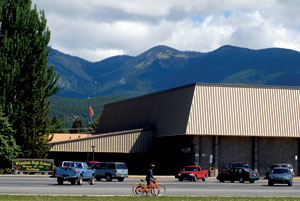What Whitefish city officials know is that they will have millions of tax increment finance dollars available for infrastructure projects in the coming years. What they don’t know is exactly how to spend those millions.
And at the heart of that question, especially in recent months, is how much can and should be divvied out to a new City Hall and an updated high school. The city council is expected to give staff direction on addressing that question at a Nov. 7 public meeting.
“Financially I think there’s room for both,” City Manager Chuck Stearns said in an interview last week. “They just have to decide how they want to consider including the school and to what level.”
In mid-October, the Whitefish City Council held a work session to discuss options for using money generated by the city’s TIF district, which sunsets in 2020. Cities use TIF districts as an economic development tool in which revenue gained from increased taxes within the district is funneled into a special fund. That money is reserved for specific projects that improve the district and hopefully encourage business growth there.
Whitefish city officials expect the TIF district to generate more than $4 million per year through fiscal year 2020, the final year before the district expires. That puts the TIF fund on pace for an ending cash balance of $10.7 million when factoring in already dedicated expenditures.
At the work session, councilors and staff discussed whether the high school would be an eligible project for TIF funds. The Whitefish school district has identified a new or updated school as a top priority. Much of the current facility is more than 50 years old, which school officials say presents a variety of concerns, including health and safety.
After a lengthy planning process that included substantial public comment, a design team has presented a proposal that would combine renovations with new construction to modernize the high school. The price tag is $18.5-19.5 million and councilors would like to know if TIF funds can be used to help pay for that figure or any other proposed figure that may arise.
During its Oct. 17 work session, the council looked at three primary options for allocating TIF funds for the high school. One is releasing revenue to all of the taxing jurisdictions that contribute to the fund. The city could also advance a certain amount of tax revenue that the school district is anticipated to receive from the city over the coming years. The city and school district have a unique interlocal agreement in which the district receives a share of residential tax increases.
 |
|
Wendy Compton-Ring walks past the front entrance of Whitefish High School. Whitefish is considering using TIF funds to help pay for a new high school. |
A third option, generally favored by the council, is adding the school to the TIF district. Stearns said the city is looking into the legal aspects of such a move, adding that “all options are still in play.”
Stearns knows of examples in which cities have made direct TIF contributions to school districts in Montana, though they generally involve lower sums of money. When he was finance director in Missoula two decades ago, Stearns said the city made a contribution to the school district from the TIF fund to help pay for windows.
“Direct grants have been made to schools in the past but the difference here is the amount of money,” Stearns said.
He also cautioned against being too liberal with interpreting TIF laws. When the state Legislature convenes every two years, Stearns said TIF districts are often a topic of conversation, particularly if a legislator perceives that a certain municipality is misusing the funds.
“When people stretch the boundaries, someone may or may not like that,” Stearns said. “Everyone has their own ideas of how tax increment funds should be used and sometimes those options differ.”
Contributing funds to a new City Hall is more straightforward. When the city adopted its urban renewal plan in 1987, it was decided that TIF funds would fund a new City Hall to avoid issuing a bond or raising taxes.
The current building was built in 1917 and the façade was refaced in 1958. City officials say there are size limitations and structural deficiencies in the building. Currently, the parks and recreation and building departments are housed in separate locations.
Based on the resolutions of past city councils, Stearns said more than $1.5 million has been allocated so far for City Hall construction. Council has the power to overturn those resolutions if it wants to use the money elsewhere.
Stearns has been meeting with Finance Director Rich Knapp and other involved parties such as the school district. He also points out that there is a list of other projects eligible for TIF funds.
“We have to look at all of our options,” he said.